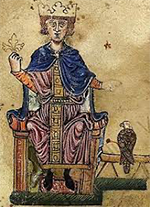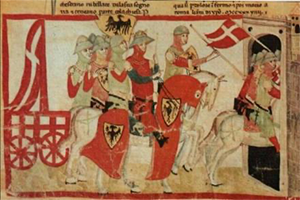Frederick II: King of Germany, Holy Roman Emperor
Frederick II was King of Germany and Holy Roman Emperor in the 13th Century. His reign was marked by intense struggles with the Catholic Church. 
He was born on Dec. 26, 1194, in Jesi, Italy. His father was the reigning Holy Roman Emperor, Henry VI and his mother was Constance, Queen of Sicily. Frederick was just 2 when his father crowned him King of the Romans, to ensure succession. A year later, Henry was dead, felled by a fever in Italy. Henry's brother Philip claimed the throne of Germany and, indeed, was so crowned in September 1198. However, that was a few months after another man, Otto of Brunswick, had been crowned with the same title. The two men battled each other for dominance for a decade, and Otto finally prevailed. Frederick, meanwhile, went to Sicily, where his mother served as regent. Frederick was crowned King of Sicily, succeeding his father, on May 17, 1198. His mother had been the daughter of the popular King Roger II of Sicily, but Henry had had to fight hard to take the Sicilian crown. As it then turned out, Frederick had to regain that crown a few years later, as a series of strongmen landed in Sicily and took control of both Frederick and the kingdom. In 1208, Frederick had himself declared of age to rule in his own right and set about asserting his authority. The pope at this time was Innocent III. He had supported Otto in the struggle to succeed Henry VI, and Innocent III had crowned Otto Holy Roman Emperor in 1209. However, Otto had a way of alienating many of his allies and so it was, too, with the pope. A short two years later, Frederick was the choice of the Diet of Nuremberg in 1211 to take over as King of the Romans. He was crowned in Mainz on Dec. 9, 1212. Otto found that he had relatively few friends and allies left. Innocent III had blessed Frederick as the new king, as had France's Philip II. The French monarch's involvement brought the English monarch, by this time John, into the fray. The two sides fought a large pitched battle on July 27, 1214, near the Bridge of Bouvines. Although Otto and John between them had 10,000 more troops than the French, they lost the battle when Otto's horse bolted from the field and his troops followed suit. The following year, Frederick pressed his advantage, taking Aachen and Cologne. Frederick had enough power in 1215 to depose Otto, and the onetime emperor fought no more. Three years later, he was dead, the victim of a disease. In the meantime, Frederick consolidated his power, both in Germany and in Italy. He finally gained the throne of the Holy Roman Empire in 1220, when he was crowned by a new pope, Honorius III, on November 22. Frederick had married Constance of Aragon on Aug. 15, 1209, in Messina, Sicily. By the time that Frederick was crowned emperor, they had had a child, Henry, born in 1211. Constance died in 1222. Henry married again, to Yolande of Brienne, also known as Isabella of Jerusalem, three years later. She died giving birth to their son, Conrad, the one of their two children who lived into adulthood. Henry's third wife was Isabella of England, whom he married in 1235. The one of their four children to live into adulthood was Margaret, born in 1241. Frederick spent relatively little time in Germany. In 1218, when he was King of Germany but not yet Holy Roman Emperor, he had thrown in his lot with France's King Philip II, helping him end a succession struggle in Champagne. After he was crowned emperor, Frederick preferred to live in Sicily, where he went about reforming that kingdom's laws. In 1211, when he was chosen King of the Romans, Frederick had vowed to go on Crusade. He sent forces to Egypt to fight in the Fifth Crusade, but he did not go himself. When that Crusade ended in failure in 1221, Pope Honorius III and others blamed Frederick for not showing leadership. In response, Frederick vowed to launch another Crusade and, in fact, go. It was seven years later when Frederick eventually sailed to the Holy Land; being excommunicated by Pope Gregory IX for delaying helped convince Frederick to go. The Sixth Crusade didn't involve as much fighting as had previous Crusades and, rather, ended in a treaty, which resulted in Frederick's being named King of Jerusalem, in March 1229. While Frederick was away, things in his Italian lands spun out of control. At the pope's direction, an army invaded southern Italy and found initial success; however, Frederick's return marked a reversal of the papal force's fortunes, and the two sides signed a peace agreement in July 1230. 
Meanwhile, Frederick's son, Henry, badly mishandled the situation in Germany, alienating the nobles so much that Frederick had return and patch things up. He did this in 1235 and then imprisoned Henry. Moving back to Italy, he diverted to Vienna, squashing a rebellion by the Austrian Duke Frederick II, and then named his son Conrad, then 9, as King of the Romans. Emperor Frederick had hoped to resolve a dispute in Lombardy without fighting, but it was not be; imperial forces invaded Lombardy and defeated the Lombard League at Cortenuova in 1237. The struggle for control in central and southern Italy continued. Frederick and an army marched on Rome. Before they could enter the city, Pope Gregory IX died. Frederick considered the fight with that pope, not the papacy in general, and so called off the attack. The next pope, Innocent IV, was no friend to Frederick, and so the war continued. A stunning defeat at Parma in February 1248 convinced the emperor to regroup. That he did and carried on the fight, spurning an attack on Sicily in the process. Frederick had increasingly directed his troops from afar. He was not with his army at the end of 1250 when, after a bout with dysentery, he died, on December 13, in Apulia. He was 55. |
|
Social Studies for Kids
copyright 2002–2025
David White




